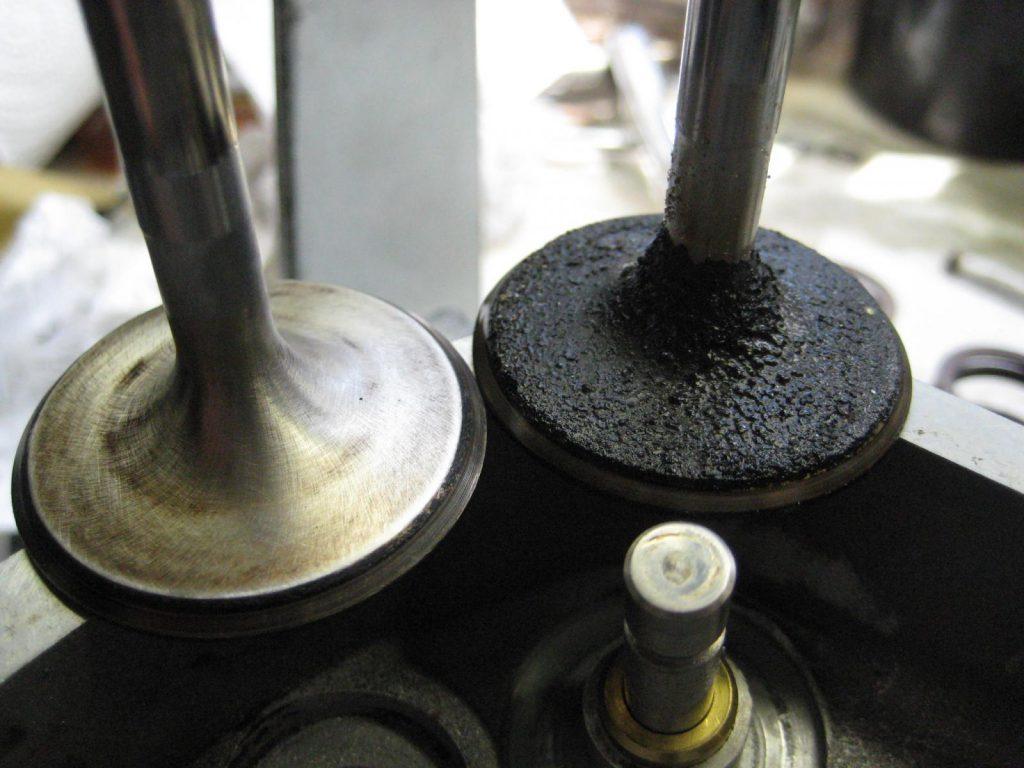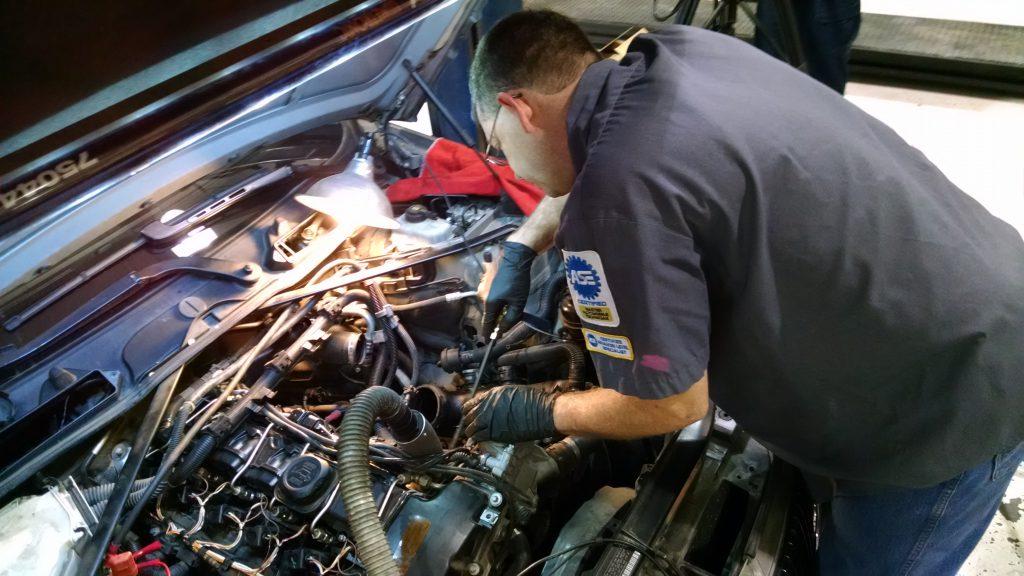Direct fuel injection in the engine is more prevalent these days because it enhances the fuel economy. However, it’s not an ideal method as carbon is deposited on the piston, intake valves, and other surfaces in the combustion chamber.
To understand how direct injection carbon builds up and prevents it, let’s consider both the aspects differently.
Contents
Direct Injection Carbon Build Up: Identifying Symptoms
Loss of power and acceleration
If you’ve noticed a substantial decrease in your car’s power and acceleration, direct injection carbon build-up might be to blame. Deposits on the intake valves disrupt proper airflow and fuel combustion, leading to compromised engine performance.
Rough idling
Carbon build-up can give rise to erratic idling or even engine stalling. This occurs when the deposits interfere with the intake valves’ proper closure, resulting in uneven airflow.
Diminished fuel economy
Are your trips to the gas station becoming increasingly frequent? Carbon build-up can hinder fuel atomization, causing inefficient combustion and subsequently decreasing fuel economy.
Elevated emissions
Carbon build-up can result in the emission of higher levels of harmful gasses. If you find yourself failing emissions tests or noticing dark exhaust smoke, it’s imperative to investigate the presence of carbon deposits.
Direct Injection Carbon Build Up: Why Does It Happen?
Without any fuss, let’s straightway jump to the reasons behind the problem.
Unable to Clean Valve and Port
The main cause of carbon buildup on valves is that the added detergents and fuel don’t come in direct contact with the intake valves.
It mainly happens because the fuel is injected directly into cylinders instead of a place behind the valve. As a result, the fuel and detergent are unable to clean the port and valve.
High Combustion Pressure
The problem gets worse during higher combustion pressure and leaner mixtures.
Actually, during direct fuel injection more energy is produced than the fuel injection from the port. So, when the sub-optimal flame front is generated, the unburned fuel increases inside the combustion chamber.
Additionally, during valve opening for intake stroke, these byproducts are exposed to the valve, thus forming the carbon deposit.
-

Symptoms of direct injection carbon build up. (Photo: WapCar)
Note: Even the air passing through the valve is not hot enough to burn these byproducts.
Cylinders Show Low Vacuum
While cranking the engine, try attaching a pressure transducer to the intake manifold. Lower vacuum during intake strokes in one or more cylinders might indicate partly clogged intakes caused by carbon buildup.
A compression test may also reveal this condition: Carbon buildup on intake ports obstructs intake air, causing cylinder compression to climb slowly, however, it finally returns to normal.
Another Cause
When the intake valve goes into the combustion chamber for a small period, the byproducts of the combustion process meet the valve, which sticks to the neck of this part.
SEE MORE:
How to Prevent Direct Injection Carbon Build Up?
With oodles of ways to prevent direct injection carbon build up, there are indeed three best possible ways you can try:
Regular Maintenance
One of the ideal ways to prevent carbon build up is periodic maintenance. While following the essential maintenance tips, the full synthetic oil is to be changed after every 5,000 miles. This allows intake valves to perform efficiently.
Spark Plug Replacement
To reduce the deposition of unburned fuel in the chambers and thus sticking it to the valves, the spark plug replacement.
Tip: Accurate time for replacing plugs depends on the recommended mileage by the factories.
Clean Up of Fuel Injectors
Cleaning is essential for correct spray of fuel into the chamber. Therefore, its service after every 30,000 miles is what can save you from huge expenditure, later.
Last but not the least, a new software update in ECM of the car can help in reducing carbon buildup on valves by adjusting the time of spark plug and valve.
-

How to stop direct injection carbon build up. (Photo: Pinterest)
Exploring DIY Cleaning Techniques
For those who enjoy a hands-on approach to vehicle maintenance, consider these DIY methods:
Thorough intake valve cleaning
Utilize a direct injection intake valve cleaner to manually eliminate carbon deposits from the intake valves.
Consistent use of top tier fuel
Consistently employing high-quality fuel can serve as a preventative measure against carbon build-up over time.
Mitigating short trips
Frequent short trips prevent the engine from reaching its optimal operating temperature, increasing the likelihood of carbon accumulation. Combine errands for longer drives whenever possible.
FAQs on Direct Injection Carbon Build Up
-
What triggers carbon build-up in direct injection engines?
Carbon build-up arises due to the absence of a fuel wash in direct injection engines, allowing deposits to amass on intake valves and combustion chambers.
-
Are all fuel injector cleaners suitable?
It is advisable to utilize fuel injector cleaners specifically formulated for direct injection engines.
-
How frequently should intake valves be cleaned?
Intake valve cleaning should ideally occur every 30,000 to 60,000 miles; however, consult your car’s manual for precise recommendations.
-
Does warranty cover carbon build-up issues?
Warranty coverage varies; therefore, consult your vehicle’s warranty documentation or dealer for comprehensive details.
-
Can I undertake intake valve cleaning at home?
Although DIY methods exist, for optimal results, it is recommended to enlist the services of a professional mechanic for intake valve cleaning.
Check out the video from Deutsche Auto Parts to understand deeply about why direct injections have problems with carbon!
Final Words
To wrap up, these tips will surely help in preventing the direct injection of carbon build up. For more information on the preventative measures, you can also consult the reputable car repair and maintenance shop.
Hopefully you will understand more about direct injection carbon build up and solutions to clean them off the valves through this article. If you have any question about this topic, feel free to leave us a comment, our auto experts will answer it for you.




Hello, I’m having trouble with my proton jumbuck 2005 with 57000 miles.
It starts when cold on the turn of the key, it drives faultlessly for around 30/40 mins,
then it like I’ve run out of fuel, it splutters along and then just stops. If I try and start the car straight away it won’t have it. But after around 5/10 mins it starts again and it will drive for around one mile before stopping again.
Can anyone help me, there mustbe someone who knows what’s going on.
I’ve had it in the garage to try and resolve the problem but they just say it’s a matter of replacing different sensors that would cost a fortune.
I would appreciate any help that anyone could give.
Thanks for reading this, I’ll keep my fingers crossed..
Regards Paul.
Hi Paul, it seems that your car shuts off while driving. Hope this article could help: https://carfromjapan.com/article/car-maintenance/car-shut-off-while-driving/
Hi
I have a opel corsa lite. it drives fine, then all all of sudden the car will starts to jurk, then when I brake to stop the revs will drop and the car stalls, It does not happen al the time, I will drive and then all of a sudden it will do that. then after the car will drive perfect. I had the car at 4 garages and the told me there is nothing wrong with my car. The last garage change the spark plugs, the car was driving fine for 3 weeks and now back to the same problem.
This sounds like the fuel pump is about to die..
Hi There
I have a Toyota Auris 2008 2.0 L engine, the car runs ok but it shows a lot of black smoke at start point and sometimes in the morning the car doesn’t start easily, my garage cleaned the EGR valve but they suggest to sell the car as cost to repair it can be too expensive, but the engine and car feels very powerful and still running ok apart from the smoke and the early morning starting problem, I wonder if someone can help here to decided what to do, at the moment the EGR valve it is being replace by a private Mechanic, I wonder if I will have to strip the engine to clean up all the carbon that produce the clog?
Thanks in advance
Jose
Hey Tsukasa! thanks for sharing your worthy tips with us. It will help me a lot.
I think the advent of these new technologies in engine management like direct injection, higher compression, turbo or other forced air systems along with higher operating temperatures will mean more maintenance. Owners should also avoid using cheap gas, and even consider premium in engines with a history of carbon buildup. Its that old saying pay me now or pay me later. The real problems come with mileage and second or third owners who lose warranties and face repairs that are costly and time consuming. Emissions regulations are trying to kill off the combustion engine. But in the mean time the owners will suffer from those regulations for some time.